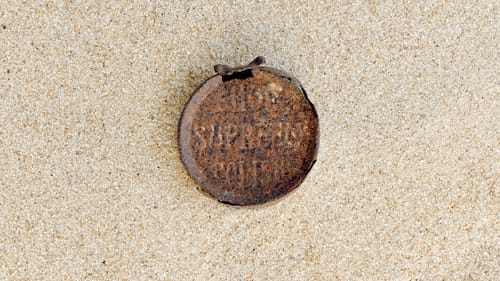Stay in the Loop
BSR publishes on a weekly schedule, with an email newsletter every Wednesday and Thursday morning. There’s no paywall, and subscribing is always free.
Worlds and wars away
Matthew Arnold's 'Topography is Fate: North African Battlefields of World War II'

“They’re quiet, very quiet. My husband and I are redoing our living room, and we want something quiet.”
Rarely would you hear similar words uttered about war photographs, yet Matthew Arnold’s latest collection Topography is Fate: North African Battlefields of World War II silently accepts and accommodates such characterization. Arnold’s debut at Gravy Studio + Gallery in Northern Liberties is composed of 19 photographs of the arid land between Egypt, Libya, and Tunisia. The photographer traveled the area to explore its effect on soldiers and travelers.
World War II and North Africa (somewhere and some time)
Although Arnold’s journeys were undertaken with a specific historical context in mind, the exhibition itself contains little mention of North Africa’s importance during World War II. After France fell to Nazi forces in 1940, Allied powers were desperate for a backdoor entry into Axis-occupied Europe. North Africa’s proximity offered the perfect solution, and for three years (1940 to 1943) the Allies struggled to gain control of the vast territory between Egypt, Libya, and Tunisia. Meanwhile, Axis forces tried desperately to cut off the Allies’ supply of oil and reinforcements.
It is easy to become lost in photographs that limn such windswept, infinite vistas, but it is useful to keep the history in mind. Without it, details that make Arnold’s photography so striking would also be lost. For example, “004, Pillbox, Mareth Line” features the location of one of the final Allied offensives in Tunisia, and the bleached, solid structure of the pillbox could easily be mistaken by the average museumgoer for, well, really any other barren cement structure, military or otherwise.
Since none of the photographs are accompanied by title or explanation, the viewer’s orientation becomes engulfed in the topography just as a soldier's might have. The photograph hangs in single file between the similarly anonymous landscapes of “005 Infantry position, Bir Hachim Battlefield, Libya” and “003 Graziani’s Fence, near Jaghbub, Libya.”

Photographing the Sand and Sands of Time
One photograph which struck me as particularly laden with both history and artistic intrigue was “003 Graziani’s Fence.” An endless plain, the sky, and sand merge along a perfectly centered horizon, interrupted only by a snaking contrail of barbed-wire fencing. Otherwise known as the "Frontier Fence," this partition was erected in the early 1930s to contain Libyan resistance against Italian colonization. The fence stretches over 200 miles — well beyond its vanishing point in Arnold’s photograph — and draws the eye along its prickly length, creating the only movement in an otherwise still landscape.
Once the line of the fence has been realized, the viewer slowly becomes conscious of faded tire tracks which approach the fence before wandering off again into the sand. How long ago did they leave? What were they doing? Why did they come, and where did they go? It’s one of the photographs that best convey a sense of the relationship between the land and a soldier’s fate.
There are several other gems in the exhibition, including a series of 12 found-object photographs pinned on the gallery’s wall. After 70 years in the desert, the various ephemera featured in the series are so weathered that “008 Lighter” looks like wood, “009 Pocket knife” like bone, and the corroded metal of “015 Shoe polish” could be mistaken for dried leather. Expertly arranged, these photographs convey the same lightness as their landscape counterparts but are more firmly grounded in the interposition of personal and topographical remains.
Why you should go
While it is easy to lose the context of World War II among these half-buried remnants and vast, sun-bleached desertscapes, this is also part of what makes Topography is Fate unique. It’s the only photography related to war that you really might place in your quiet living room. The exhibition offers a startling perspective in a world of bombs and bombast; while a new view of war may not solve conflict, it can only add to the ways we can, and should, reflect upon it.
What, When, Where
Topography is Fate: North African Battlefields of World War II. By Matthew Arnold. Through April 28, 2018, at the Gravy Studio + Gallery, 910 N. Second Street, Philadelphia. (267) 825-7071 or gravy-studio.com.
Sign up for our newsletter
All of the week's new articles, all in one place. Sign up for the free weekly BSR newsletters, and don't miss a conversation.

 Helen Walsh
Helen Walsh